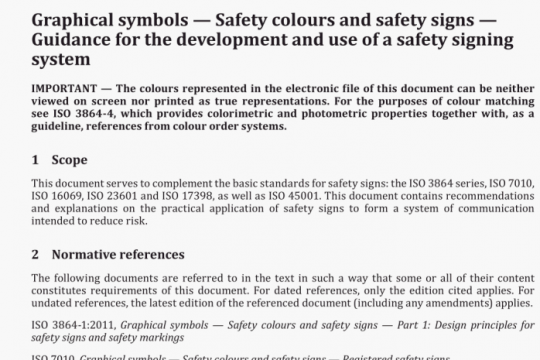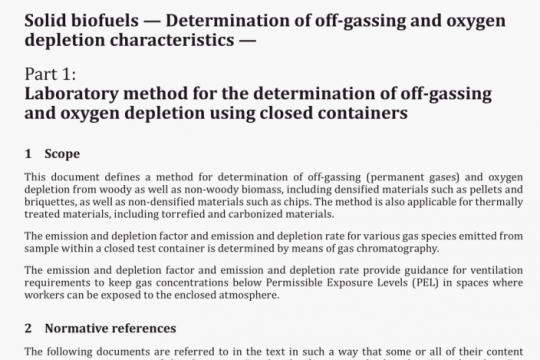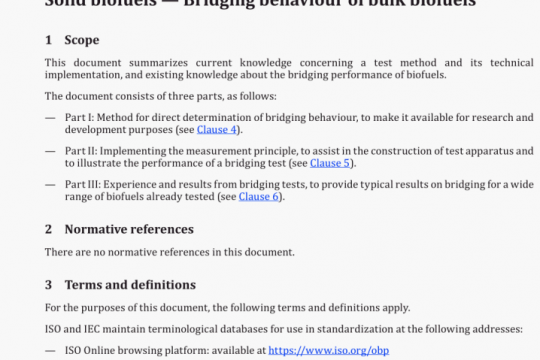ISO 21927-3 pdf free download
ISO 21927-3-2021 pdf free download.Smoke and heat control systems – Part 3: Specifications for powered smoke and heat exhaust ventilators.
Selection ofthe motors shall conform with the following requirements:
— Motors shall conform with the requirements oflEC 60034-1.
— Motor ratings shall be limited by the temperature rise for one class lower than the insulation class ofthe motor, as defined in IEC 60085.
— The fan tested in accordance with 5.32 shall conform with the stability requirement in C.4.2.2.
4.3 Effectiveness ofsmoke/hot gas extraction
4.3.1 General
The effectiveness ofsmoke/hot gas extraction ofthe fan is the ability to continue to extract the required volume flow at high temperature.
4.3.2 Gas flow and pressure maintenance during smoke and heat extraction test
The effectiveness of smoke/hot gas extraction is demonstrated by conformance with the performance requirements in C.5., when tested according to 5A.
4.4 Resistance to fire
The fan is shown to be functioning satisfactorily by its continued ability to provide the initial volume or pressure within the defined limits in C.1S. when tested according to .
The test result shall be classified in accordance with EN 13501-4.
4.5 Ability to open under environmental conditions
4.5.1 Opening under wind load within a given time
When the fan is fitted with shutter. louvers or dampers, their ability to open under environmental conditions shall be demonstrated by fulfilling the requirements in &S when tested in accordance with
4.5.2 Opening under snow load within a given time
When the fan is fitted with shutter, louvers or dampers, their ability to open under environmental conditions shall be demonstrated by fulfilling the requirements in L5 when tested in accordance with
4.6 Durability ofoperational reliability
Durability of operational reliability is demonstrated by motor rating according to 4.2.3 when tested according to .51.
5 Testing, assessment and sampling methods
5.1 General
PSHC ventilator (fan), tests shall be carried out in accordance with Annexes A. B and E.
For each test, a test report shall be prepared in accordance with Annex C.
CQpynQh 4PatQ4 Oivniiflon lot Sa,vizcn © ISO 202 1 — All rights reserved
ISO 21927-3:2021(E)
A fan can be tested completely assembled with ancillaries, for example:
— flexible connection elements;
— anchors (fastenings for mounting to external structure);
— airflow operated dampers or external powered dampers;
— shock absorber (anti-vibration mount);
— sound absorber (silencer or acoustic attenuator);
— support construction (e.g. for powered roofor partition fans);
— thermal protection (e.g. PTC thermistor, Thermocouple, PtlOO, etc.);
— ON-OFF switch and other electrical ancillaries (e.g. electrical safety box) which are directly mounted on the fan;
— guide vanes;
— flow deflectors;
— a jet fan shall be tested completely assembled and suspended from a supporting construction in accordance with the manufacturer’s installation instructions.
For testing of motors alone, tests shall be carried out and test reports prepared in accordance with Annex D.
5.2 Test of response delay (response time) opening under wind / snow load within a given time
5.2.1 Wind load
The fan shutter, flaps or louvers shall open in less than 30 s against a horizontally applied load of 200 Pa, simulated by means of an additional fan blowing on the flap at a suitable velocity, or by any suitable mechanical means when the fan is tested in accordance with Annex E and/or Annex C.
WARNING — For fans which use the air pressure from the fan to open flaps or louvers.
Due to the temperature rise, the density of air decreases resulting in a corresponding decrease in the pressure developed. This pressure is needed to open the termination system (flaps or louvers).
In this case, the laboratory shall perform the wind load test also during the high temperature test.
If fans selected according to Annex A and tested according to Annex C are intended for use with external, air-pressure operated shutters, the combination shall also be tested with a wind load according to Annex E.
The operating position can be considered as reached if the volume flow exhausted by the fan working under wind loads did not decrease by more than 10 % of that exhausted by the fan working without these loads.
If a fan intended for mounting on an external wall is fitted with external shutters, flaps or louvers and/or is not protected from wind force acting against it by a deflector or cowl, it shall be tested in accordance with this Clause. Otherwise, the manufacture shall include a statement in his instructions that suitable wind guarding shall be fitted by the installer.ISO 21927-3 pdf download.




